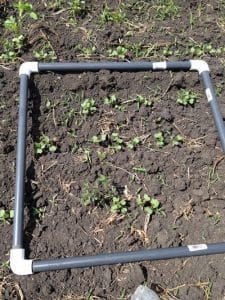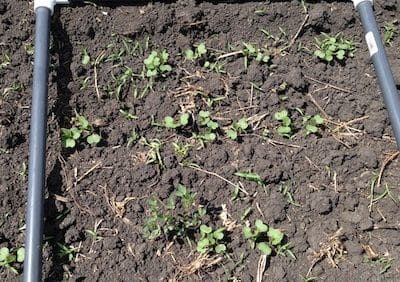We had a grower ask about how many seeds per square foot he would have if he seeded 5g thousand kernel weight (TKW) seed at 5.5 lb./ac. Here are the steps to calculate:
1. Convert lb./ac. to grams/ac. 5.5 lb./ac. multipled by 454 (the number of grams in a pound) equals 2,497 g/ac.
2. Use the TKW to calculate seeds per acre. Divide 2,497 by the TKW then multiple by 1,000 to get seeds per acre. 2,497 ÷ 5 x 1,000 = 499,400 seeds per acre.
3. Divide by square feet in an acre (43,560) to get seeds per square foot. 499,400 ÷ 43,560 = 11.5 seeds per square foot.
If seed survival is 60%, which is fairly typical, this seeding rate will provide around 7 plants per square foot — which is within the ideal range.
A rule of “fives” that you might remember is this: 5g TKW seed at 5 lb./ac. seeding rate and 50% survival will provide a stand of just over the minimum recommendation of 5 plants per square foot.

Growers can make more of their seed investment by taking steps to increase seed survival.
Tips to increase seed survival…
Seed shallow. Half an inch to one inch below the packer furrow is the recommended seed depth for canola. This will reduce days to emergence and reduce the seed energy required for emergence.
Seed at a consistent depth. The more consistent the better. For some drills, the overall average may be one inch, but the range could be 0”-2”. Too shallow or too deep both contribute to seed and seedling mortality, and those that do emerge will have highly variable emergence dates, creating an uneven field.
Seed slower to ensure good and even seed depth from all openers. The ideal speed will vary by drill and soil conditions. In general, at higher speeds, rear openers tend to throw more soil over the front rows. Seed in these front rows will be buried deeper, making them slower to emerge — if they emerge at all. Re-check depth when moving from one field to the next.
Limit seed-placed fertilizer. Nitrogen fertilizer placed in the seed row can increase seedling loss to due toxicity and salt effect. Safe rates of seed-placed nitrogen range from 0 to 50 lb./ac. (over and above N in P fertilizer) depending on soil type, soil moisture conditions and seed-bed utilization. The best practice is to place only phosphate fertilizer with the seed at rates up to 30-40 pounds of phosphate per acre, and then put the rest of the N and other nutrients away from the seed row. The more fertilizer put down at seeding, the farther away it should be from the seed row.
Penetrate trash. Spread residue evenly in the fall, and have a drill that can penetrate trash so all openers place seed into the soil.
Leave a firm seedbed. Openers that fracture the seedbed to place fertilizer lower than the seed may not provide the firm moist seedbed that canola needs. Worn openers that do not provide a defined seed ledge and high fan speeds that cause seed bounce can also reduce an opener’s ability to place seed precisely.
Pack appropriately. In wet conditions, reduce packing pressure to limit hard crusting. In dry conditions, pack more to conserve moisture in the seed row. Packing pressure can be a delicate balance, and often changes by soil type as well as moisture conditions.
Rotate crops. A tight canola rotation will increase the risk from seed and seedling diseases that can prevent emergence.
Seed into warmer soils. This can greatly increase survival but this needs to be balanced against the benefits of early seeding. Canola seeded early May yields higher, most years, than canola seeded late May, but this yield benefit depends on stand establishment. The best plan is to aim to seed early and use the other tips listed above to increase seed survival.
A note on seed size. A recent AAFC study “Seed size and seeding rate effects on canola emergence, development, yield and seed weight” led by Neil Harker concluded that: “Seed size effects on canola emergence, yield or seed quality were not significant. Increasing seed size had a positive linear association with early canola biomass and 1,000-seed weights, whereas, both days to flowering and days to the end of flowering had a negative linear association with seed size. Greater biomass from large seeds increases crop competition with weeds and also hastens flowering, shortens the flowering period and reduces the risk that canola will be exposed to high temperatures that can negatively impact flowering and pod development.”
Seeding into warmer soils speeds up emergence and makes it more uniform. However, the yield benefits of seeding early May versus late May are too important (most years) to ignore.

